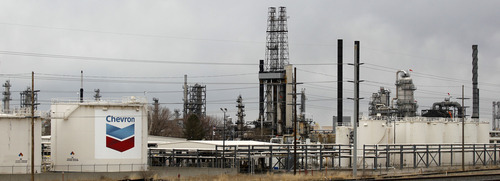This is an archived article that was published on sltrib.com in 2012, and information in the article may be outdated. It is provided only for personal research purposes and may not be reprinted.
Chevron Corp. has launched a major effort to upgrade its crude oil processing unit at its Salt Lake City refinery.
The announcement earlier this week by the giant U.S. energy company marks the third planned refinery expansion for the area revealed in recent months.
The upgrade, expected to be completed in summer 2014, is projected to cost around $83 million.
"This project will help us improve both the reliability and efficiency of our oil-processing equipment, some of which dates back to the early days of the refinery's career," said Greg Hardy, Chevron's spokesman in Salt Lake City.
The Chevron refinery at 2351 N. 1100 West began operating in 1948, shortly after the discovery of the Rangely crude oil field in western Colorado that was an important source of feedstock for the plant.
Hardy said the upgrade will be completed in stages, which means that the refinery will remain in production while the work is under way.
Chevron isn't the only company updating or expanding its refinery operations in Utah.
Tesoro Corp. announced in December that it planned to invest $180 million to expand crude oil processing at its refinery near the Chevron facility. And that was followed less than a month later by HollyFrontier announcing it planned to invest $225 million over the next two years to increase production by 45 percent at its Woods Cross refinery.
Lee Peacock, president of the Utah Petroleum Association, said those investments suggest the companies are anticipating the market for their products will be growing in Utah, as well as in the surrounding states they serve.
"The tone of our state's economy is such that companies are willing to invest in Utah because they see a bright future," he said.
HollyFrontier and Tesoro and have indicated their plans are to increasingly make use of the black-wax and yellow-wax crude oils that are being produced in greater quantities in eastern Utah's Uinta Basin.
Hardy said Chevron's project won't increase the refinery's capacity — it processes 45,000 barrels per day — but will enable it to more easily handle a wider range of locally and nationally produced crudes, such as those from eastern Utah.
The waxy crudes come out of the ground at a consistency similar to petroleum jelly. Unlike the so-called light, sweet crudes that are popular feedstocks for refining, the high-wax varieties are thick and viscous, and usually aren't transported by pipeline. Instead, they typically are shipped by insulated tankers and must arrive at their destinations within four to eight hours so they don't solidify. If that happens, the tanker's cargo must be warmed up before it can be pumped into the refinery.
Chevron's plans to upgrade its Salt Lake City refinery came to light earlier this week when Michael Wirth, the executive who oversees Chevron's refining business, announced the initiative during a meeting with securities analysts in New York.
Twitter: OberbeckBiz



